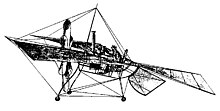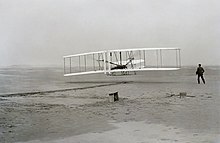
The Wright brothers, Orville Wright and Wilbur Wright, were American aviation pioneers generally credited with inventing, building, and flying the world's first successful airplane. They made the first controlled, sustained flight of an engine-powered, heavier-than-air aircraft with the Wright Flyer on December 17, 1903, four miles (6 km) south of Kitty Hawk, North Carolina, at what is now known as Kill Devil Hills. In 1904 the Wright brothers developed the Wright Flyer II, which made longer-duration flights including the first circle, followed in 1905 by the first truly practical fixed-wing aircraft, the Wright Flyer III.

Samuel Pierpont Langley was an American aviation pioneer, astronomer and physicist who invented the bolometer. He was the third secretary of the Smithsonian Institution and a professor of astronomy at the University of Pittsburgh, where he was the director of the Allegheny Observatory.

The history of aviation spans over two millennia, from the earliest innovations like kites and attempts at tower jumping to supersonic and hypersonic flight in powered, heavier-than-air jet aircraft. Kite flying in China, dating back several hundred years BC, is considered the earliest example of man-made flight. In the 15th-century Leonardo da Vinci created several flying machine designs incorporating aeronautical concepts, but they were unworkable due to the limitations of contemporary knowledge.
This is a list of aviation-related events from 1903:

Glenn Hammond Curtiss was an American aviation and motorcycling pioneer, and a founder of the U.S. aircraft industry. He began his career as a bicycle racer and builder before moving on to motorcycles. As early as 1904, he began to manufacture engines for airships. In 1908, Curtiss joined the Aerial Experiment Association, a pioneering research group, founded by Alexander Graham Bell at Beinn Bhreagh, Nova Scotia, to build flying machines.

Traian Vuia or Trajan Vuia was a Romanian inventor and aviation pioneer who designed, built, and tested the first tractor monoplane. He was the first to demonstrate that a flying machine could rise into the air by running on wheels on an ordinary road. He is credited with a powered hop of 11 m (36 ft) made on 18 March, 1906, and he later claimed a powered hop of 24 m (79 ft). Though unsuccessful in sustained flight, Vuia's invention influenced Louis Blériot in designing monoplanes. Later, Vuia also designed helicopters.
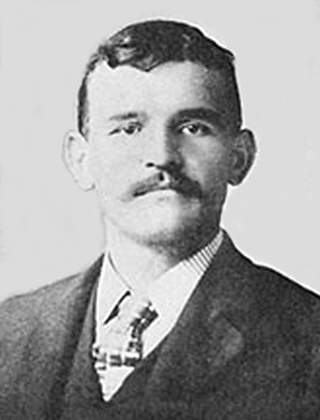
Gustave Albin Whitehead was a German–American aviation pioneer. Between 1897 and 1915, he designed and built gliders, flying machines, and engines. Controversy surrounds published accounts and Whitehead's own claims that he flew a powered machine successfully several times in 1901 and 1902, predating the first flights by the Wright brothers in 1903.
This is a list of aviation-related events from 1902:

The June Bug was an American "pioneer era" biplane built by the Aerial Experiment Association (A.E.A) in 1908 and flown by Glenn Hammond Curtiss. The aircraft was the first American airplane to fly at least 1km in front of a crowd.
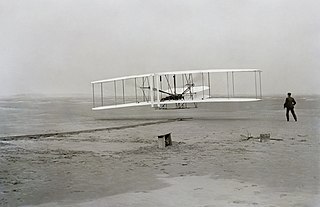
The Wright Flyer made the first sustained flight by a manned heavier-than-air powered and controlled aircraft on December 17, 1903. Invented and flown by brothers Orville and Wilbur Wright, it marked the beginning of the pioneer era of aviation.

The 14-bis (French: Quatorze-bis;, also known as Oiseau de proie, was a pioneer era, canard-style biplane designed and built by Brazilian aviation pioneer Alberto Santos-Dumont. In 1906, near Paris, the 14-bis made a manned powered flight that was the first to be publicly witnessed by a crowd and also filmed. It was also the first powered flight by a non-Wright Brothers airplane aside from short powered "hops" by Clément Ader and Traian Vuia.

A steam-powered aircraft is an aircraft propelled by a steam engine. Steam power was used during the 19th century, but fell into disuse with the arrival of the more practical internal combustion engine at the beginning of the pioneer era.

Early flying machines include all forms of aircraft studied or constructed before the development of the modern aeroplane by 1910. The story of modern flight begins more than a century before the first successful manned aeroplane, and the earliest aircraft thousands of years before.

The Langley Aerodrome is a pioneering but unsuccessful manned, tandem wing-configuration powered flying machine, designed at the close of the 19th century by Smithsonian Institution Secretary Samuel Langley. The U.S. Army paid $50,000 for the project in 1898 after Langley's successful flights with small-scale unmanned models two years earlier.

History by Contract is a 1978 book by early aviation researchers Major William J. O'Dwyer, U.S. Air Force Reserve (ret.) and Stella Randolph about aviation pioneer Gustave Whitehead. The book focuses on a 1948 agreement between the Smithsonian Institution and the estate of Orville Wright, which stipulates that the Smithsonian, as a condition of owning and displaying the 1903 Wright Flyer, must recognize and label it as the first heavier-than-air machine to make a manned, powered, controlled and sustained flight.
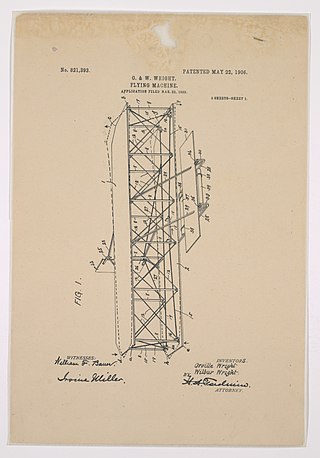
The Wright brothers patent war centers on the patent that the Wright brothers received for their method of airplane flight control. They were two Americans who are widely credited with inventing and building the world's first flyable airplane and making the first controlled, powered, and sustained heavier-than-air human flight on December 17, 1903.

L’Aérophile was a French aviation magazine published from 1893 to 1947. It has been described as "the leading aeronautical journal of the world" around 1910.

The Winds of Kitty Hawk is a 1978 American made-for-television biographical film directed by E. W. Swackhamer about the Wright brothers and their invention of the first successful powered heavier-than-air flying machine, the Wright Flyer. It's a tribute to the brothers and was broadcast on December 17, 1978, the 75th anniversary of their famous 1903 first aeroplane flight. It is one of several made-for-television films about historical people in aviation produced in the 1970s, including The Amazing Howard Hughes, Amelia Earhart, and The Lindbergh Kidnapping Case.

The Vuia 1, also nicknamed Liliacul, was a pioneer aircraft designed and built by Romanian inventor Traian Vuia. It was finished in December 1905 in France and first flew on 18 March 1906 at Montesson.
